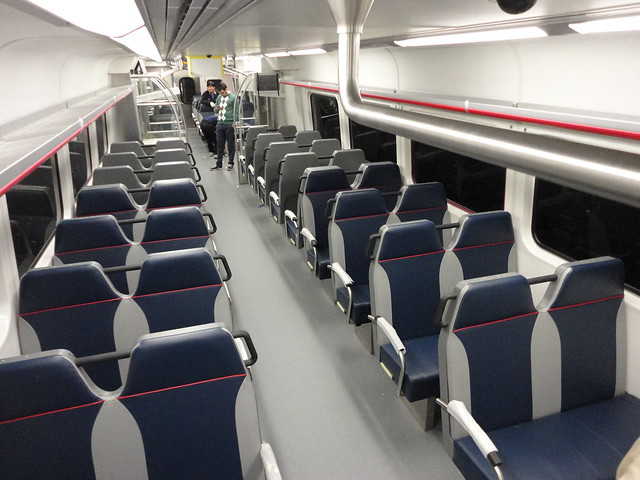Thank you for this post.
Safety is another problem with the FRA rules. The requirement, for many years, was a rigid structure like a '48 Rambler. The European and Japanese trains are built with crumple zones, like an '08 Mercedes. In a collision, which offers better protection, an old Nash or a new Benz?
I hear the safety requirements have been updated, and the cars are being built like Ramblers with Mercedes noses welded on. It's an improvement, but we still have to buy overweight and expensive custom-built short production run technology rather than mass produced modern equipment.
While of course by nature, rail-automobile comparisons have their limits, many might think within these limits it is a good illustration. Many might agree with you, in that the Federal Railroad Administration (FRA) should abandon the current regulation which many might think of as antiquated, and instead allow modern mass produced modern equipment to operate.
Many might think it's sad that it's generally the case outdated FRA rules still apply, at the same time there are what many might consider positive developments, in that the FRA granted waivers to several rail operators, so they are able to use modern and efficient rolling stock. For example, there is
- in New Jersey, New Jersey Transit's River Line commuter rail, using special tram-train-operations capable Stadler GTW 2/6 Diesel-Multiple Unit trainsets offering a tighter turning radius
- in Texas, Capital Metropolitan Transportation Authority's Red Line commuter rail, using modern Stadler GTW 2/6 Diesel-Multiple Unit trainsets
- again in Texas, Denton County Transportation Authority's A-Train commuter rail, also using modern Stadler GTW 2/6 Diesel-Multiple Unit trainsets
- in California, North County Transit District's Sprinter commuter rail, using customized modern Siemens Desiro Classic Diesel-Multiple Unit trainsets
Modern, not FRA compliant rolling stock will also be used:
- in California, on San Francisco Bay Area Rapid Transit District's eBART service, once again using modern Stadler GTW 2/6 Diesel-Multiple Unit trainsets
- in Texas, on Fort Worth Transportation Authority's future Cotton Belt commuter rail line, using some modern yet-to-be-determined Diesel-Multiple Unit
- and in California (this project might be very important to some), on Peninsula Corridor Joint Powers Board's Caltrain commuter rail, using modern yet-to-be-determined Electric-Multiple Units, which will offer lower operating costs, faster acceleration and shorter travel times, a more comfortable ride and a more attractive service (the FRA waiver already has been granted)
So some might think, there is hope.

Being able to use light-weight rolling stock would be beneficial for nearly every kind of passenger rail operations, still besides commuter rail, high-speed rail stands to gain the most. After all, some might think that one of the reasons Amtrak's Acela wasn't able to make full use of all of high-speed rail's advantages was the thousands of modifications that had to be made in the attempt to basically convert an off-the-shelf TGV design into a more-or-less custom-built FRA compliant US rolling stock. This is why many were so excited about the Federal Railroad Administration's (FRA) efforts to change US regulations regarding safety requirements for passenger trains, including high-speed rail, to basically allow modern light-weight designs to operate - without time-seperated operations and the like. Crafting regulations takes time, so at least for some it may remain one of the most exciting developments, and some may be waiting for more news on this process moving forward or eventually being finished. The following is an article about this from last year:
Long Barred from American Tracks, European Train Designs Could Get Rolling by 2015
October 31, 2013
By Stephan J. Smith
http://nextcity.org/daily/entry/modern-european-train-designs-american-tracks-2015-fra
Thank you for this post.
By contrast, I would point out the fact that crumple incidents are where things tend to go very, very wrong with trains. As a rule, at least from what I can recall, as long as the car structure holds up people don't tend to get killed. When a car gets squished, the story changes. Put another way, US trains do have crumple zones: The couplings. The fact that trains can bend every 80 feet creates a sort of crumple zone. Additionally, it's a hell of a lot harder to put a hard stop on a million-pound Regional than it is on a 2000-pound car. The sheer mass of the train tends to take out whatever is in its way where a similar obstacle will stop a car hard. Take a large tree, for example: A lot of cars will slam into it and get wrapped around it. If a locomotive hits the same tree, you might have an emergency stop (and indeed it might induce something of a derailment) but the train isn't likely to get torn to shreds.
Many might think, it is sure legit to see it that way. At the same time, many might respectfully disagree.
By contrast, I would point out the fact that crumple incidents are where things tend to go very, very wrong with trains.
Some might think, no, that's when things go right. Modern safety principles recognize that every crash is basically one object moving into some other object with a certain amount of energy, thus what is needed is crash energy management, and crumble zones are one important component of that, so sometimes it could be that when something crumbles, that is where things tend to go comparatively good with trains.

One example how work is being done on crumble zones (and standard couplings are not actual crumble zones at all) can be found here:
Will the crash zone crumple? FEA tells
November 6, 2003
By Paul Dvorak
http://machinedesign.com/archive/will-crash-zone-crumple-fea-tells




